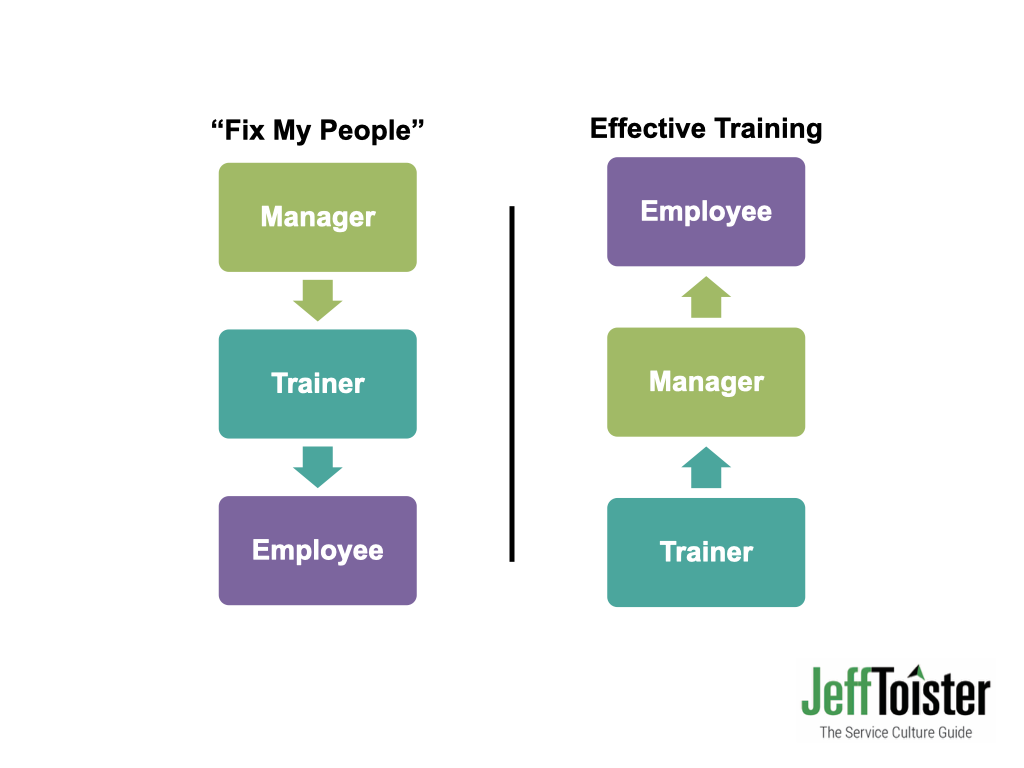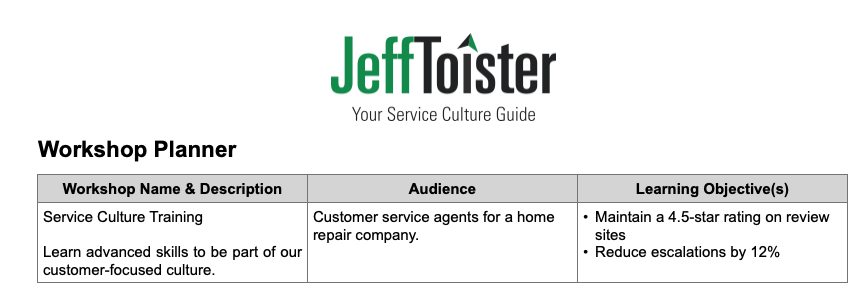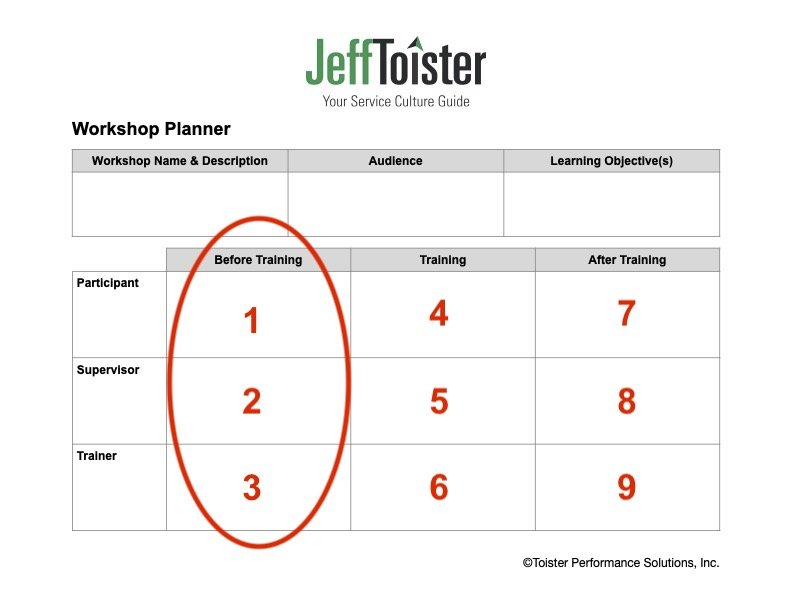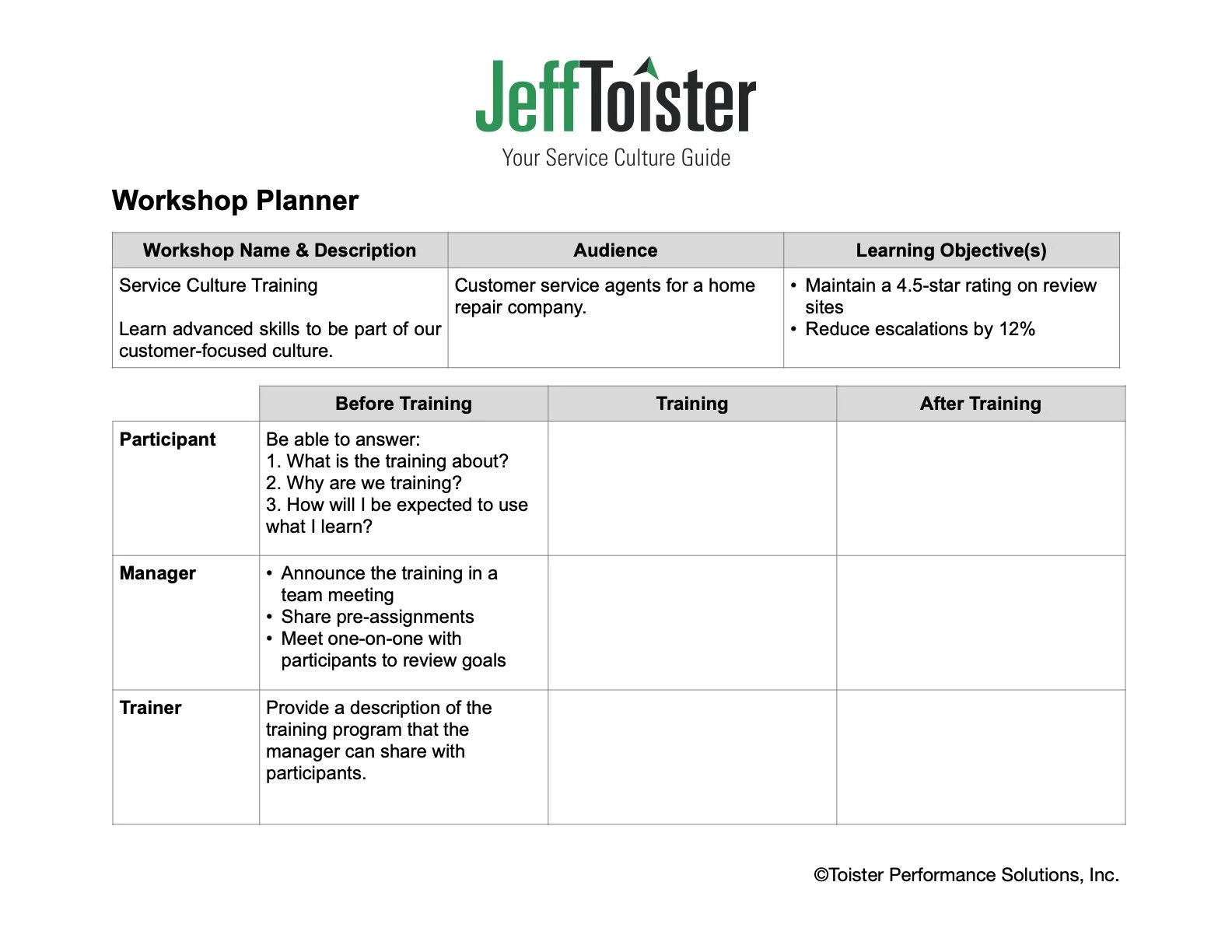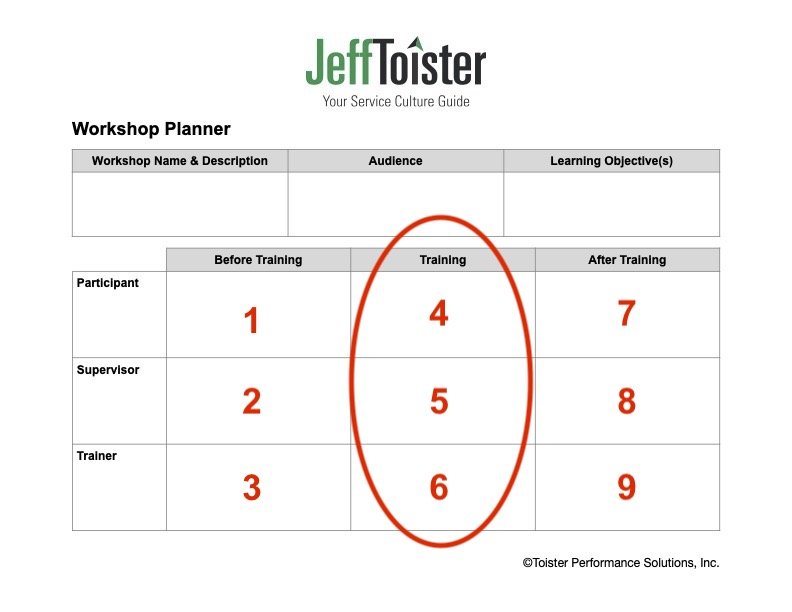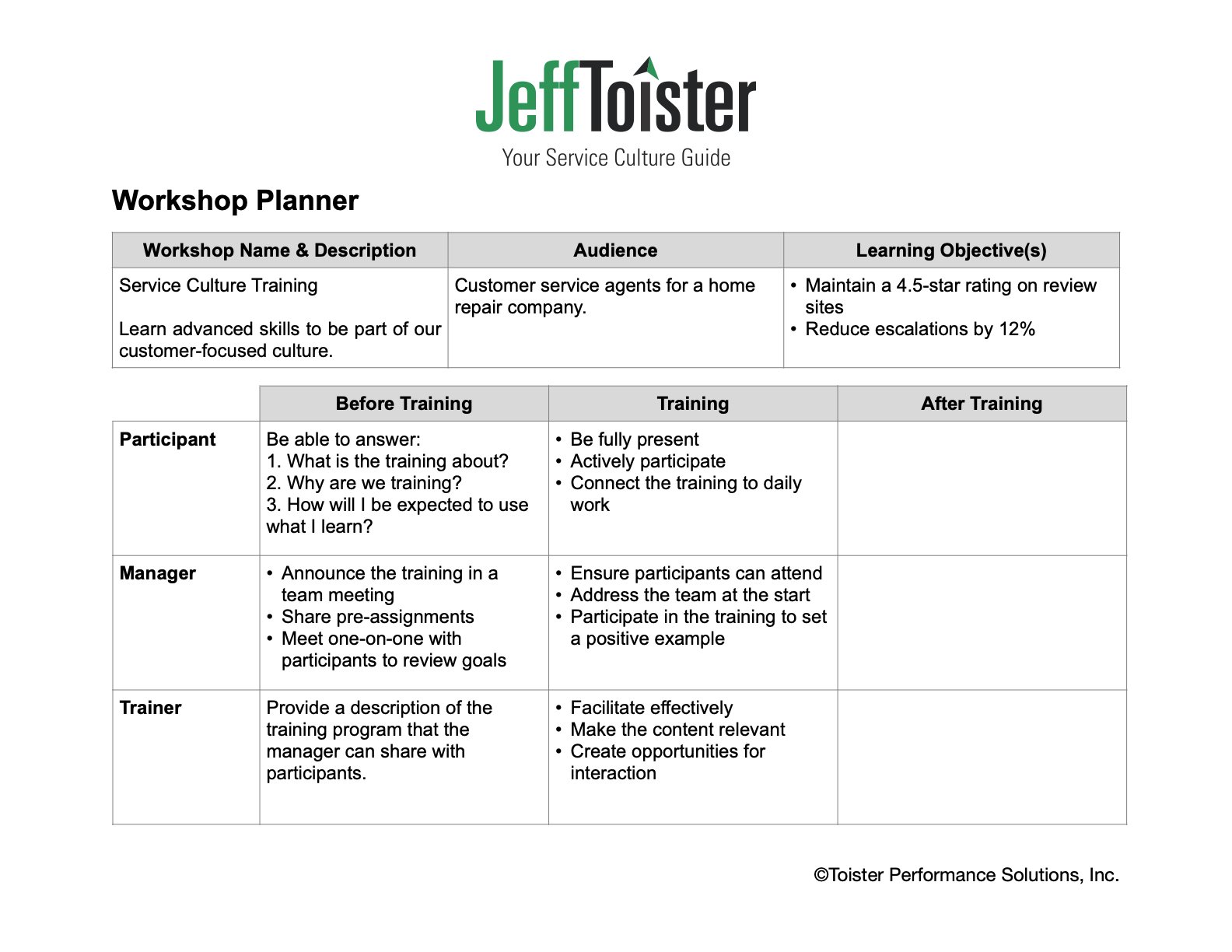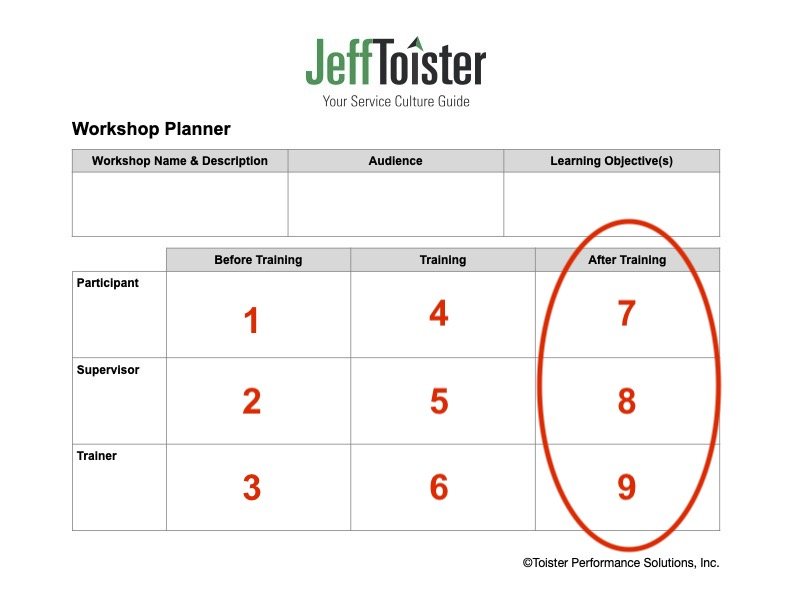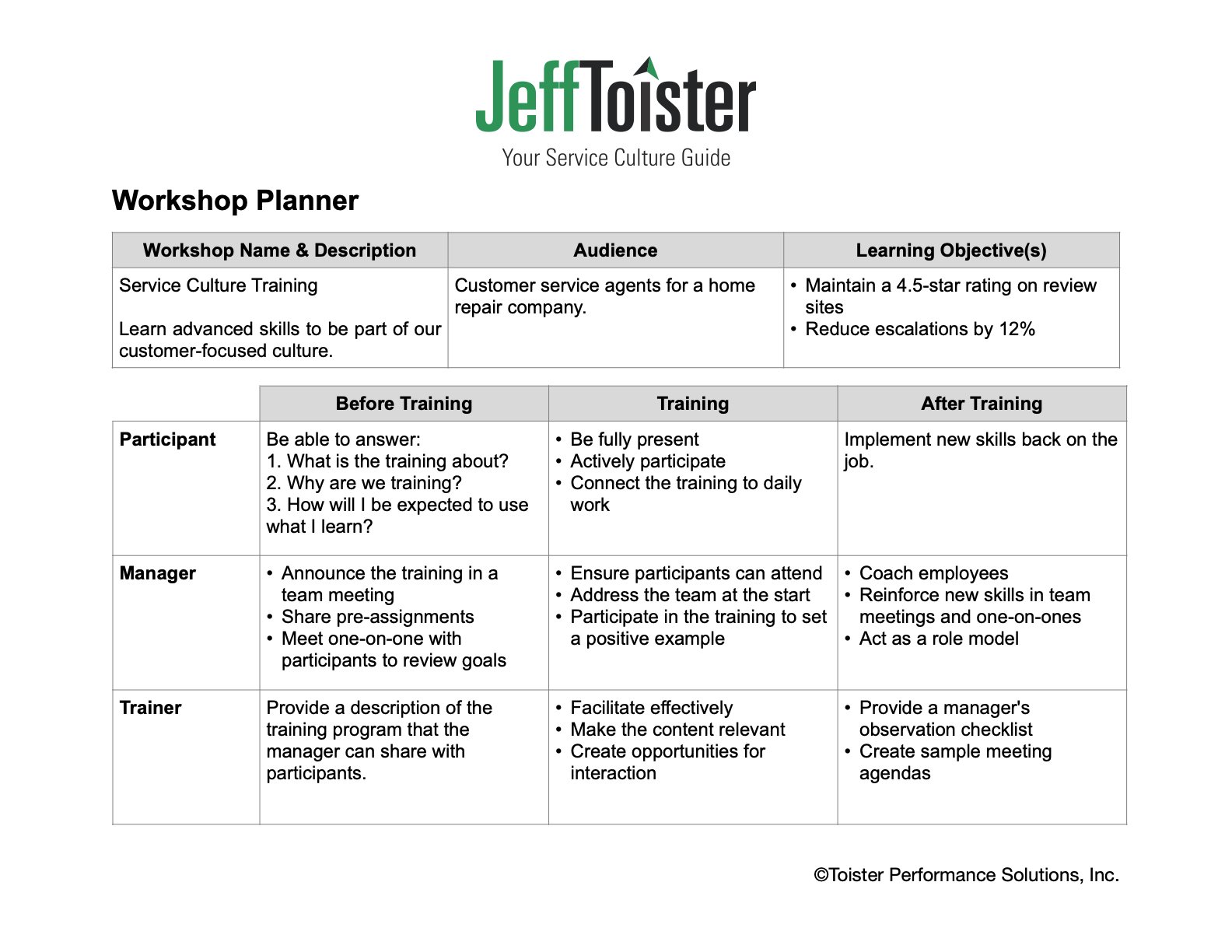You're a customer service trainer.
You care deeply about helping employees develop customer service skills. It bothers you when employees' managers aren’t nearly as invested.
These managers take a "fix my people" approach. The manager delegates customer service training to you and expects you to do all the work. They fail to reinforce the training and employees quickly go back to their old habits.
It's a broken model.
This problem plagued me for years until I found a solution. It's a simple worksheet that you use to complete an action plan with the employees' manager before training.
Let's take a closer look at the process. You’ll be able to download the worksheet at the bottom of this post.
Meet with Managers
Ask the employees' manager to join you for a one-hour planning meeting. If more than one manager is sending employees to training, ask all of the managers to attend the same session.
You can schedule separate sessions with managers as a backup if you're unable to get them all to attend at the same time.
What if managers won't attend the planning meeting?
As an external trainer, I have the luxury of turning down the business. I simply won’t take a job where the manager refuses to do their part because I know the training is likely to fail.
You might not have the ability to turn down the training request, especially if you are an internal employee. Here are a two alternatives:
Offer to reschedule the training for a time when the manager has more bandwidth.
Use the manager who doesn't attend as a control group for an experiment. Compare their results to the managers who do attend the meeting.
Now, let's walk through the worksheet and the meeting flow.
Step 1: Confirm objectives
Start by filling in the informational boxes at the top of the worksheet. This information is usually set before the training is scheduled, but it helps to make sure you and the manager are on the same page.
Workshop name and description
Audience (who is attending training)
Learning objective(s)
The learning objectives section is an opportunity for the manager to explain what they hope the training to accomplish.
I recommend focusing on two things during this phase of the discussion:
Making the objectives specific and measurable
Ensuring the objectives can be reasonably accomplished with training
Here’s a sample worksheet:
The training program was for customer service agents at a home repair company. Agents handled initial customer calls, set appointments, alerted customers when technicians were due to arrive at their homes, and kept customers updated on projects that required multiple visits.
The rest of the worksheet is laid out to focus on the participant first, then the manager or supervisor, and finally the trainer.
Step 2: Before Training
The next step is to create an action plan to prepare participants to get the most out of the training program.
Box 1: Start by asking the manager what participants should do before the training program so they're fully prepared. Keep it simple—you want any pre-work to be quick, focused, and easy to complete.
At a minimum, I recommend making sure participants can answer three questions:
What is the training program about?
Why are we doing the training?
How will I be expected to use what I learn?
Record these actions in Box 1.
Box 2: Now, ask the manager what they will do to ensure participants complete the action items listed in Box 1. Write those down in Box 2.
Typical examples include:
Announcing the training in a team meeting
Sharing any pre-assignments with participants
Meeting one-on-one with participants to review learning goals
Box 3: Finally, ask the manager what support they need from you, the trainer, to prepare their participants for the training program.
This might include sharing a flyer, short video, or some other marketing material the manager can use to promote the upcoming training with their team. Write those actions in Box 3.
Here’s a sample from the home repair company:
Step 2: Training
This next phases focuses on what the participant should do during training to get the most out of the learning experience.
Box 4: Ask the manager what they'd like participants to do during the training. Common responses include:
Be fully present
Actively participate
Connect the training to their daily work
Write these down in Box 4. Remember to keep it simple. Just a few reminders will do.
Box 5: Next, ask the manager what they will do to ensure participants fulfill the items listed in Box 4. Here are a few typical examples:
Adjust schedules so participants can attend
Address the team at the start of the training so they know its importance
Participate in the training to set a positive example
Write those actions in Box 5.
Box 6: Finally, ask the manager what they expect from you during the training. The most common responses include:
Facilitate effectively
Make the content relevant
Create opportunities for interaction
Write those actions in Box 6.
Here’s a sample from the home repair company. Notice the actions are straightforward. You don’t need a lot of steps to create a solid action plan.
Step 3: After Training
This section is used to craft a plan to help participants implement what they learned in training. It includes a reinforcement plan that is driven by the manager or supervisor.
Box 7: Start by asking the manager what they'd like participants to do to apply what they learned in training. The response is often simply, “implement the new skills.”
It's helpful to tie this back to the learning objectives that you discussed at the start of the meeting.
Write those actions in Box 7.
Box 8: Next, ask the manager what they will do to reinforce the training and ensure participants apply what they learned back at work.
I've been really impressed by what managers come up with here. A few examples include:
Observe employees using the new skills and offer feedback
Reinforce the new skills in team meetings and one-on-ones
Demonstrate the new skills to serve as a role model
Those actions go in Box 8.
Box 9: Finally, ask the manager what support they need from you to help reinforce the training. This usually includes a request for support materials and reminders.
Fun fact: my Customer Service Tip of the Week email was born out of one of these discussions.
Record those actions in Box 9. Your action plan is now complete.
Here’s an example of the completed Workshop Planner for the home improvement company. The entire plan was created in just one hour.
Resources
Here are the resources you need to use this Workshop Planning tool the next time you organize a customer service training program.
Download the tool here:
Watch a short video on how to use it. This video comes from my LinkedIn Learning course, How to Design and Deliver Training Programs.


